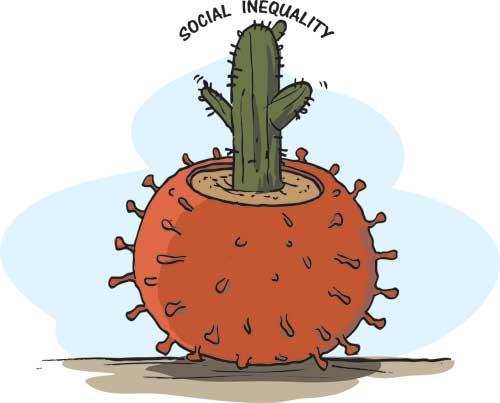19 Oct 2020 - {{hitsCtrl.values.hits}}
The Institute of Policy Studies (IPS) in its report on the ‘Status of the Economy’ revealed that income inequality in  the country is growing, and is a rising problem across the country for the past 25 years.
the country is growing, and is a rising problem across the country for the past 25 years.
In 2016, 50% of Sri Lankan households earned less than Rs.39,855 per month. With the average household consisting approximately four persons (3.8 to be exact), this sum was and is not sufficient to sustain a family of four persons; with the average cost of two meals per family being around Rs. 24,000/-. This does not leave money for medical requirements, travel, education, recreation or savings.
Although Sri Lanka has managed to reduce income poverty from 26.1% in 1990/91 to 4.1% by 2016, income inequality has remained unchanged for more than four decades. The richest 20% of the population enjoy more than half the total household income of the country, while the poorest 20% get only 5%. The situation of the poorest 10% of the households is worse, with their share of household income being just 1.8% or less.
In January 2020, the economically-active population of Sri Lanka stood at 8.6 million. Of this, the private sector employed around 3.5 million people, whilst own account or self-employed workers numbered to 2.7 million. The informal sector employment constitutes more than 3.3 million employed population. What is worse is that a significant section of the working population does not have any form of social security, making them highly vulnerable in the event of loss of income. It was in this situation, COVID-19 struck the country in 2020.
A survey carried out by the Department of Labour showed a total of 596,022 workers were employed in mercantile establishments, which responded to the survey in February 2020. This number had fallen to 213,011 by May 2020, indicating that 64.26 % of employees were not in work or unemployed by May 2020. What this survey has not revealed is, that even those workers in the mercantile sector who did not lose their employment had to work on a 50% salary cut. The Labour Department survey in summary revealed, 64 % of the total employed in February 2020 was unemployed by May.
"Today, once again businesses are facing closure, thousands of people have contracted the dreaded disease, schools and universities have been shut and many thousands more face loss of employment, poverty and hunger"
In the aftermath of the country being hit by COVID-19 leading to mass job losses, the government commenced a programme to assist the general public who have lost their daily income, through personal grants of Rs.5,000/- per family. In April, according to government statistics, 1.7 million persons received this Rs.5,000/- allowance on the basis of loss of income.
While the action of the government was commendable, it also revealed that 1.7 million of the working population lost their source of livelihood.
Soon measures adopted by the government helped bring the virus under control. By August, the situation had eased so-far-as-to permit the conducting of the general election. All appeared to be well and the government even received the plaudits of the UN for keeping COVID-19 under control.
However with the new developments, once again businesses are facing closure, thousands of people have contracted the dreaded disease, schools and universities have been shut and many thousands more face loss of employment, poverty and hunger.
Government is forced to spend millions on medical facilities and medicament to help the innocent victims.
Today, people are blaming the President and his government for what they see as a great injustice being imposed on them. Ordinary folk are being fined and arrested for what they see as mere curfew violators.
The lapse on the part of someone who is responsible for the origin of the second wave of COVID-19 may have been unintentional, but Justice must not only be done it MUST be seen to be done.
30 Nov 2024 3 hours ago
30 Nov 2024 4 hours ago
30 Nov 2024 4 hours ago
30 Nov 2024 6 hours ago
30 Nov 2024 9 hours ago